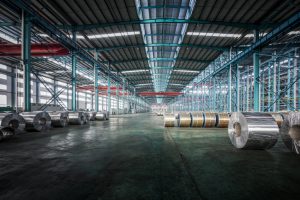Under the coronavirus pandemic, there has been a trend like consumption from staying at home. As a result, online sales has finally been accelerated, even in automotive.
The pandemic that occurred globally has brought various changes in our daily lives.
Especially, mobility, which mediates the transportation, is one of the domains greatly affected by the novel coronavirus, movable together with people.
Under the lockdown policies in many countries around the world, people’s freedom of movement has been restricted in many regions. In Japan, the Ministry of Health, Labour and Welfare has requested people to practice new behaviors to avoid “the 3Cs.” (i.e. closed spaces, crowded places, and closed-contacts)
Based on these circumstances, the meaning of owning and driving privately owned car is being reassessed, and there are some survey results showing people who recognize the automotive as a safer mean of transportation in terms of reducing infection risk, as well as an increase in desire to purchase automotive vehicle. (*1)
Online sales of cars, which had seemed sluggish compared with other industries, have been also promoted, possibly due to such lockdowns and increased needs for private cars under the pandemic. Toyota reported that the majority of its April sales volume in North America was via online sales (*2).
Not all customer contact points concerning automotive are completed online. An omni-channel that combines the offline and the online is needed. What can we learn from cases of omni-channel precedents in other industries?
It does not mean that automotive sales and services are going to all migrate online right now. Rather, as long as the automotive vehicle has hardware parts, there is a need to check and test drive for the customers, and the work of after-sales vehicle inspection, maintenance, and parts replacement by mechanics, will continue.
In short, what to realize is the so-called omni-channel – that is, how to maintain the customer support and service of existing offline channels while fusing these with online customer contact (thereby sharing customer needs and purchasing data across channels, and from this creating optimal and consistent customer experiences*3).
Then, how are other industries approaching omni-channels?
Here are some references to the omni-channel concept found in financial industry.
Concept of the omni-channel in financial industry (*4)
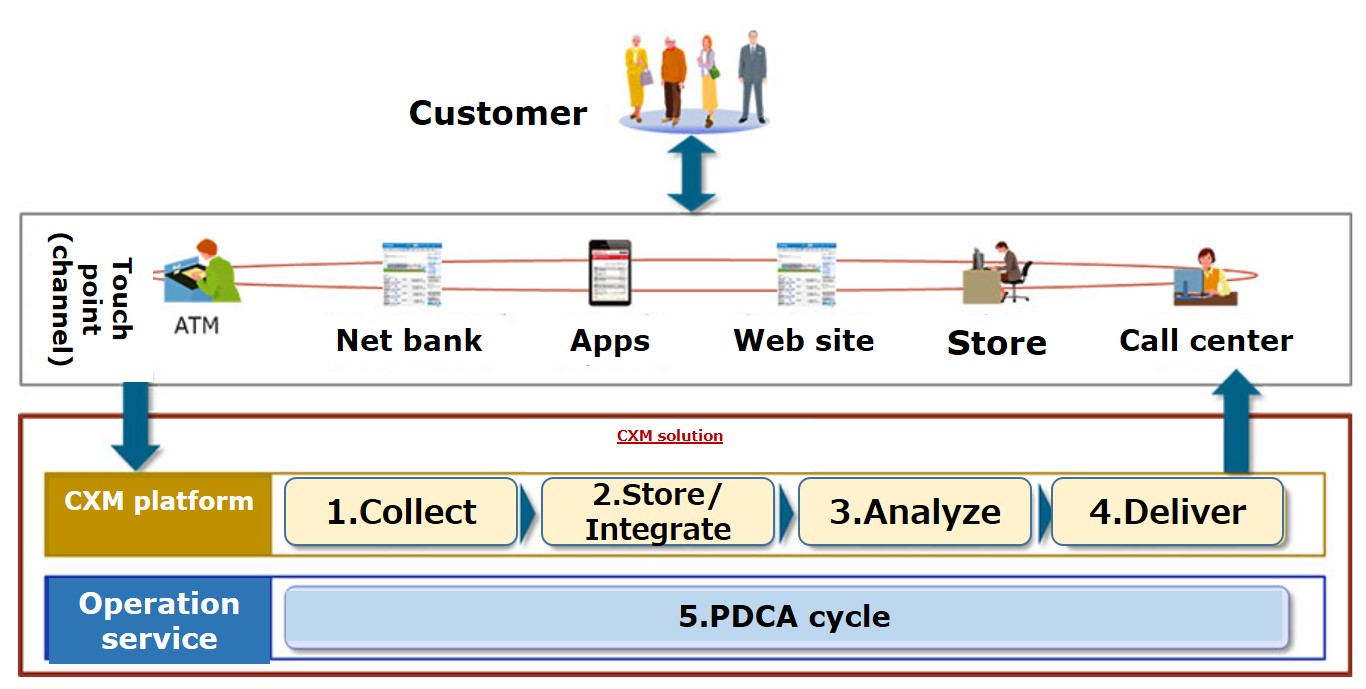
Resona Group’s omni-channel strategy (*5)
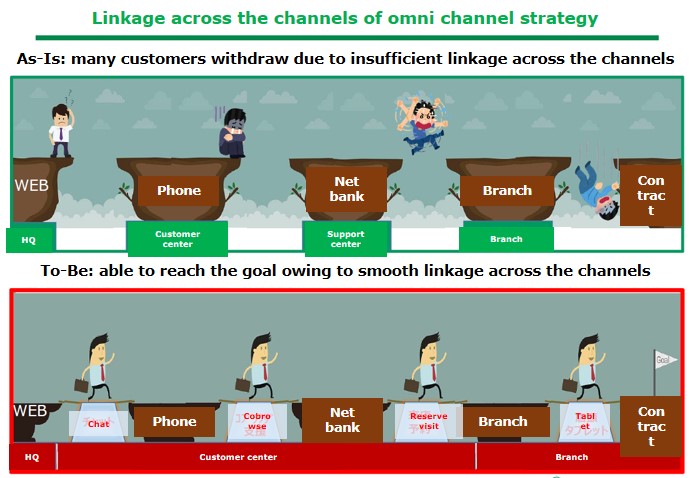
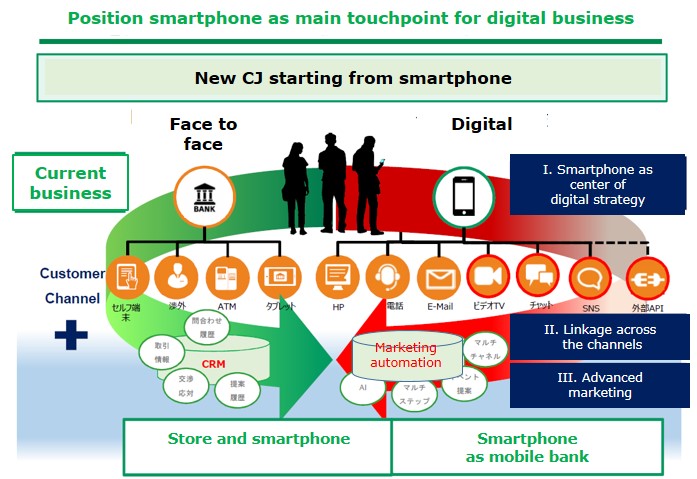
Through data linkage and analysis among different customer points of contacts owing to the omni-channel, it is possible to provide customers with consistent customer experiences at any customer touchpoint, with improving the accuracy of marketing measures.
As in the above example concerning financial industry, the omni-channel aims to provide the optimal customer experience (CX) by linking and analyzing data among different channels to design the optimal customer journey (CJ).
If CJ can be visualized from end-to-end, not from siloed perspective, it will be possible to more accurately evaluate the effects of marketing actions.
As a result, the next actions to be taken will be more and more accurate, and marketing PDCA will run as a positive spiral.
From a customer’s perspective, if the content and timing of marketing offers proposed to the customer are optimized and CX is improved, satisfaction and loyalty toward the store and the brand will increase.
Not satisfying with simply optimizing CX and CJ, if we perform end-to-end linking of data from the entire automotive value chain (VC), analyze causal relationships of varied events throughout the VC, and feed those results back to the VC upstream and to the next project, we will be able to create an ecosystem that sustainably strengthen the VC overall.
If we perform data linkage and analysis not only for sales and marketing processes but also for across the entire processes of the long life cycle that spans development and production to after-sales service, this will enable not only improvement in the accuracy of sales and marketing actions, and CX and CJ optimization as described above, but also optimization of the entire VC in the enterprise.
Stated more concretely, it will be possible to conduct remarkably more efficient and accurate feedback and analysis of causal relationships among various events occurring throughout the VC, such as how vehicles were made, how they were used, and what happened as a result (for example, all the product failures and defects happened in the lifetime).
By repeating this analysis/feedback cycle across the divisions in the enterprise, it would turn out to be an ecosystem that strengthens and improves the level of the manufacturing and marketing VC overall.
Concept of the ecosystem (*6)
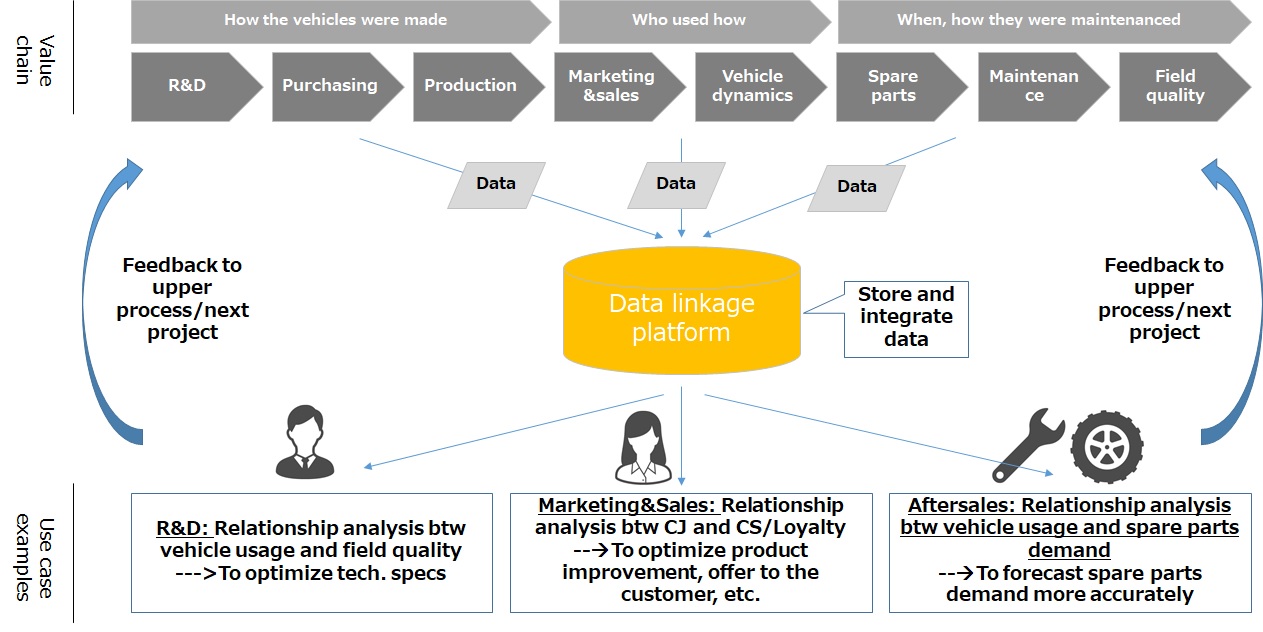
A data collaboration platform is required to realize this ecosystem. Before investing in the platform, a small start to confirm the effects with a POC, and cross-departmental leadership, will be key success factors.
Linking data across the VC is easier said than done, and will require considerable workloads and investment to coordinate interests among departments, form consensus, and design and build the IT architecture.
As the team-work effort is needed among the colleagues who share the values, directions and a ToBe image, collaborating for at least several months or possibly even years, it will be vital that strong cross-departmental leadership provides support.
If the project can be started by linking and analyzing data from multiple departments over a fixed period of time as a POC, with confirmation of effectiveness by related parties, then it will be possible to make a small start and steadily achieve business outcomes while compressing investment risk.
Even in physically contact-free, remote customer support is desired in the period of living with the coronavirus, what would be more important than ever before to understand the customer is data with making the best use of it. Based on such sort of platform mentioned above, now is the time to operate and utilize the data ecosystem to realize DX, in the era of with/post coronavirus.
Sources
*1: (1) “People who intended to buy a car” (18%) outnumbered “People who cancelled or postponed the purchase decision” (11%) due to the pandemic; (2) Recognize that automotive vehicle would provide with safe transportation necessary in daily life (80%), (3) Transportation by automotive vehicles were increased in eight prefectures under special emergency orders, especially in Tokyo (26%: +10pt compared to nationwide), “Consumer Survey on Transportation and Automotives amid the Coronavirus Pandemic,” Delphys Inc., May 2020
*2: “Toyota’s April sales in the US were 84,694 units; nearly all of the 80,000 units after excluding sales for governmental agencies were reportedly online sales. Toyota has not disclosed actual numbers, but confirmed that the majority were online.” “Online Sales Take Off Under the Novel Coronavirus; becoming mainstream even for Toyota in the US,” Nikkei Business Electronic Edition, May 2020
*3: CX Clip (https://cxclip.karte.io/topic/omni-channel/)
*4: Launch of CXM Solution to strengthen customer touchpoint for financial industry, NTT DATA Corporation, September 2019
*5: Resona Group’s Digitalization Strategy, Resona Holdings Omni-Channel Strategy Department, April 2018
*6: Created by SC-Abeam Automotive Consulting
– end –






